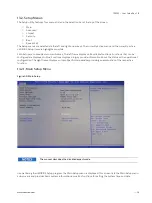
CP3005 – User Guide Rev. 1.8
// 83
12/
Installation
This chapter is oriented towards an application environment. Some aspects may, however, be applicable to a
development environment.
12.1.
Safety
To ensure personnel safety and correct operation of this product, the following safety precautions must be observed:
All operations involving the CP3005 require that personnel be familiar with system equipment, safety requirements
and the CP3005.
This product contains electrostatically sensitive components which can be seriously damaged by electrical static
discharge (ESD). Therefore, proper handling must be ensured at all times.
Whenever possible, unpack or pack this product only at EOS/ESD safe work stations. Where a safe work station is not
guaranteed, it is important for the user to be electrically discharged before touching the product with his/her hands
or tools. This is most easily done by touching a metal part of your system housing.
Do not handle this product out of its protective enclosure while it is not used for operational purposes unless it is
otherwise protected.
Do not touch components, connector-pins or traces.
Kontron assumes no liability for any damage resulting from failure to comply with these requirements.
12.2.
Board Installation
The CP3005 is designed for use either as a CompactPCI system controller or as an autonomous CPU board in a
CompactPCI peripheral slot.
When installed in the system slot, the CP3005 provides all required functions for supporting the hot swapping of
peripheral boards which are capable of being hot swapped. In this configuration the CP3005 itself is not hot-
swappable.
When installed in a CompactPCI peripheral slot, the CP3005 operates autonomously, meaning that it only draws
power from the CompactPCI backplane. There is no interfacing with the CompactPCI bus, clocks or other control
signals. In this configuration, the CP3005 supports hot plugging. This simply means that the board can be installed or
removed from the system while under power.
Always ensure that all functions in progress are properly terminated or put into a safe state
prior to hot plugging the CP3005. Failure to comply with the above may result in improper
operation or damage to other system components, e.g. operating system failure, data loss,
uncontrolled processing, etc.
In order to use the hot plug function of the CP3005, a hot swap-capable backplane is
required.
12.2.1.
Standard Board Insertion
Prior to following the steps below, ensure that the safety requirements are met.
To insert the CP3005 in a system proceed as follows:
1.
Ensure that no power is applied to the system before proceeding.
2.
Insert the board into the slot designated until it makes contact with the backplane connectors.
3.
Using the ejector handle, engage the board with the backplane. When the ejector handle is closed, the board
is engaged.
















































